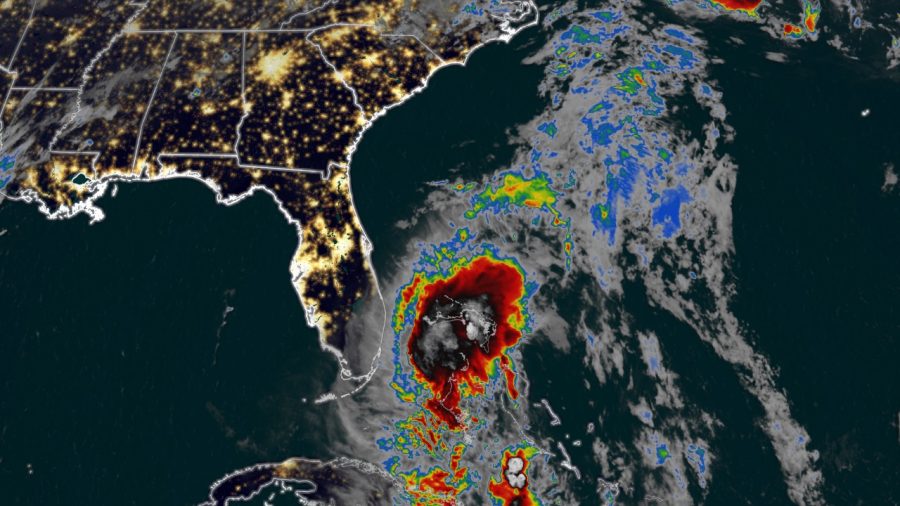Tropical Storm Isaias to ride Florida’s east coast, bringing high winds and heavy rain
Forecasts show Tropical Storm Isaias making landfall between Charleston, SC, and Myrtle Beach Monday overnight.
August 2, 2020
CNN — Florida began to feel the effects Sunday of a powerful storm that’s inching in the state’s direction — and is expected to hug its east coast until Monday.
Tropical Storm Isaias was located about 75 miles southeast of Vero Beach as of 2 p.m. ET.
Track the storm’s path
The storm has maximum sustained winds of 65 mph. After battering Grand Bahama Island early Sunday, a tropical storm warning was in effect from Jupiter Inlet, Florida, to Surf City, North Carolina. A tropical storm watch continues up the coast to Duck, North Carolina.
The wind and rain seemed to be dying down in Freeport, Bahamas, midday Sunday, but not before giving Sidneka Munroe a scare. Heavy rains brought floodwaters up to 3 feet high, she told CNN, and if the storm had been any stronger or longer, she fears, it would’ve damaged her and her family’s home.
“It was pretty terrifying, not knowing what to expect. The area we live in only started flooding since Dorian (in 2019), so the first sign of sunlight, it was necessary to see how bad the flooding was. This storm brought a lot of rain, for sure.”
Forecasts indicate Isaias will not regain hurricane strength. Its center is expected to remain five to 10 miles off the coast as it moves north along Florida, but it could make landfall Sunday, forecasts say.
A storm surge watch is also in effect from Edisto Beach, South Carolina, to Cape Fear, North Carolina, while a storm surge of up to 4 feet is expected in portions of the Carolinas.
Forecasts show the storm making landfall between Charleston, South Carolina, and Myrtle Beach by Monday evening.
US East Coast to get drenched
Isaias is threatening Florida with winds capable of damaging roofs and buildings and destroying some mobile homes, according to the National Weather Service in Miami.
The storm will also dump up to 6 inches of water over parts of the state, and up to 7 inches in parts of the Carolinas and mid-Atlantic states. As it treks along the coast, Northeast Florida and coastal Georgia will see up to 4 inches of rain.
“Heavy rainfall from Isaias could result in potentially life-threatening flash flooding in the Bahamas and flash and urban flooding along the East Coast of the United States,” according to the National Hurricane Center.
“Minor river flooding and isolated moderate river flooding is possible across portions of the Carolinas and mid Atlantic,” the weather service said. By the time the storm moves further north Tuesday, southeast New York and parts of New England could see up to 6 inches of rain.
The system already drenched the Bahamas after crossing over Andros Island as a Category 1 hurricane Saturday morning, leaving in its wake downed trees and power outages.
Along Florida’s southern coast, isolated tornadoes could peel off roofs and snap off branches, the weather service said.
As Gov. Ron DeSantis warned, many Floridians were left without power. About 27,400 customers were experiencing outages; Palm Beach County being the hardest hit with almost 10,000 customers losing electricity, according to Florida Power & Light’s outage map.
The utility has 10,000 workers ready to respond, the governor said before the storm’s winds hit the coast.
States of emergency
In preparation for the storm, North Carolina and Virginia declared states of emergency, allowing officials to move resources and equipment for recovery. In Florida, the governor issued a state of emergency for several counties and encouraged all parts of the state to accept evacuees so as not to overcrowd local shelters.
North Carolina Gov. Roy Cooper authorized up to 150 members of the state’s National Guard to be used if needed, his office said. The storm’s center could affect the state early Tuesday.
“As we learned with Hurricane Florence, even a Category 1 storm can bring severe impacts, and we should not take this lightly,” Cooper said in a statement.
State ferries were also assisting residents and visitors evacuate Ocracoke Island, where officials said there’s potential for flooding and storm surge.
In South Carolina, where the governor hasn’t ordered an emergency declaration, some local governments are gearing up for what the storm could bring.
Myrtle Beach issued a civil emergency declaration on Friday. North Myrtle Beach also declared a state of emergency Friday. In Charleston, officials said the city began reserving pumps to position in low-lying areas in the case of flooding.
In Virginia, the governor said high winds and flooding will likely impact parts of the state.
“This state of emergency will ensure localities and communities have the assistance they need to protect the safety of Virginians, particularly as we continue to deal with the Covid-19 crisis,” Gov. Ralph Northam said in a statement. “I encourage Virginians to take all necessary precautions, monitor local weather forecasts, and stay alert.”
The-CNN-Wire™ & © 2020 Cable News Network, Inc., a WarnerMedia Company. All rights reserved.









